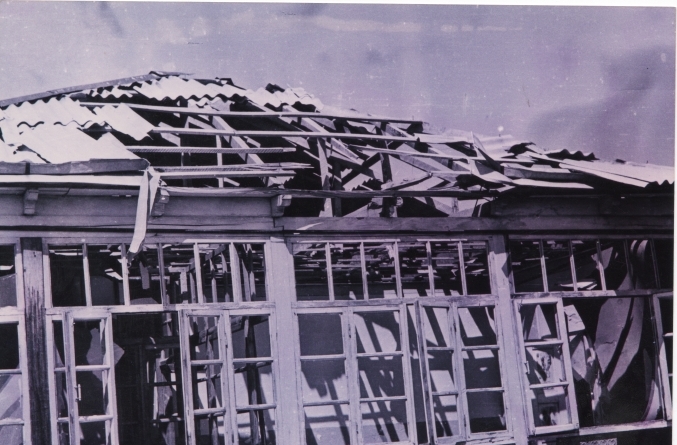Baghanis Ayrim tragedy
Baganis Ayrim village was located in Eskipara administrative territorial unit of Gazakh district. This village which was founded at the beginning of the 18th century and was formerly called Seyid Ayrim, was attacked by Armenians at times and as a result of wich, it was forced to change its original location. Armenian hypocrisy and Russian support played significant role in these changes. The insidious intentions of the Armenians continued even in the Soviet era, in 1984-85, 2105 hectares of land from Gazakh district were given to Armenia, and 42 hectares of the land of Baganis Ayrim village were "donated" to them. That is why Baganis Ayrim was surrounded by Armenian villages.
450 people lived in the village before the occupation. There were 101 houses and 113 farms in Baganis Ayrim. The number of livestock and cattle of the population was over 300. The community was mainly engaged in cattle breeding and beekeeping. There were an elementary school, a medical center, a club, a library and 2 stores in the village.
The village of Baganis Ayrim, which, together with the villages of Ashagi-Askipara and Yukhary-Askipara, was subordinate to the M. Sabir Grape state farm, used to be engaged in tobacco farming, and since 1975 they have been engaged in viticulture.
A 2 km long highway connecting Georgia with Armenia passed through the village of Baganis Ayrim.
This road was very important and necessary for Armenians.
On the night of March 23-24, 1990, Baganis Ayrim village of Gazakh region was occupied by Armenian armed bandits. Armed from head to toe, the enemy attacked the village at night, robbed and burned houses killed innocent people, and burned the villagers alive. As a result of the occupation of Armenians, a family of 5 people - Asliyev Dadash, his wife Pakiza, daughters Havakhanim, Aliya, grandson Hafiz and one more villager Almammad Maharramov, 6 villagers were burned, policeman Majid Ahmadov was killed. Besides 1 policeman and 1 villager were injured. The oldest of the burned villagers was a 75-year-old man, and the youngest was a 39-day-old baby. During this tragedy, 17 houses were burned, 11 houses were looted, the population was displaced from their native homes and dispersed in different places of the region.
 Thus, Baganis Ayrim gone down in history of Azerbaijan as the first village which was occupied and burned.
Thus, Baganis Ayrim gone down in history of Azerbaijan as the first village which was occupied and burned.
Since the Armenian armed forces who committed a massacre in the village of Baganis Ayrim went unpunished, 2 years after this incident, on the night of February 25-26, 1992, they repeated this bloodshed on a larger scale and committed genocide against the Azerbaijani people.
As a result of Armenia's military aggression against Azerbaijan, the villages of Baganis Ayrim, Yukhari Eskipara, Ashagi Eskipara, Kheyrimli, Gizil Hajili, Sofulu, Barkhudarli of Gazakh region were burned, looted and destroyed by the armed forces of Armenia. 6,500 people were forcibly displaced from the occupied territories. As a result of occupation of 7 villages of Gazakh region, which are still under occupation today, material and cultural samples were looted, destroyed and burned. Thus, in the village of Yukhari Eskipara, a fortress from the V-VIII centuries, the Shekargala temple complex from the X century, Burj from the XVII century, Catyr bridge, Kazim bridge, etc. architectural monuments, as well as an underground road dating back to the XIV century, an eight-year school, a medical center, a club and a library with a book fund of 10,048 copies were destroyed. 1 secondary school, hospital, culture house, 2 libraries with 6,850 and 9,980 book collections were destroyed in the village of Ashagi Eskipara. Besides Kheyrimli village libraries with 8512 book collections, Kizilhacli village libraries with 10335 book collections, Sofulu village libraries with 14829 book collections, Barkhudarlı village libraries with 16105 book collections, as well as public catering facilities, schools, hospitals were destroyed. As a result of the occupation, a total of 8 library branches and 178285 copies of books belonging to them were burned and destroyed.
Recommended literature:
- Paşayeva Qənirə, Akif Aşırlı. Ermənilərin törətdiyi soyqırımın qurbanı - Bağanıs Ayrım / Q. Paşayeva, A. Aşırlı. - Bakı: Elm və təhsil, 2016. - 116 s.
- Мәммәдов, Елчин Мәҹид оғлу. Бу, әсл фаҹиә иди / Е. М. Мәммәдов ; ред. Н. Ә. Һәсәнзадә. - Бакы : Азәрбајҹан нәшријјаты, 1999. - 128,[8] с.
- Paşayeva, Ganire. Ermenilerin Yaptığı Soykırımın Kurbanı: Bağanıs Ayrım / G. Paşayeva, A. Aşırlı. - Bakü : Elm və təhsil, 2012. - 134 s.